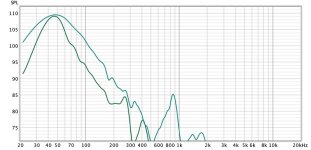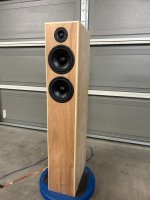I have attached a picture of 2 different port responses in 2 different speakers. One response has a much steeper "low pass" response. One is less steep and is only down about 10db at 100HZ. Is there a better way to control this? Can anyone shed some light on why they would be so different? Both ports are 2" in diameter and about the same length. Both cabinets are about 1.2 cubic feet internal volume. One box has 2x Scanspeak 5.5" woofers and the other box has a Purifi 6.5" woofer.
Thanks!
Thanks!
Attachments
I have wondered about this too, I read in David Weems book that speaker Q and port Q are inversely proportional to each other.
WinISD and other programs don't mention it directly, with Ql, Qa, and Qp and such applying to the box.
I heard that a passive radiator Q increases as mass is added.
I would like to know more, if anyone knows.
WinISD and other programs don't mention it directly, with Ql, Qa, and Qp and such applying to the box.
I heard that a passive radiator Q increases as mass is added.
I would like to know more, if anyone knows.
Basically it's about how much does it 'ring', so the pioneer's 'critically' damped them as required.

Last edited by a moderator:
The Q should be inversly correlated with damping material causing reisistive losses of the box-vent resonans system. So try adding or removing damping materal. Also try moving it around with a set amount of damping material.
Basically it's about how much does it 'ring'
If a ported system "rings", would it be the port, the box, or the speaker?
In a suitable alignment, would all ringing be suitably damped, that being the point of a suitable alignment?
I'm about to build a ported sub, my second ported system, would I be able to hear the 25Hz tuning frequency if it rang? Or the speaker's 50Hz frequency?
I have measurement systems, so I will be able to find out, but I have noticed the different "port Q" responses like the OP when trying different designs in WinISD and VituixCAD.
Just curious.
The helmholtz-resonator (box+port) "rings" at the resonance (bass reflex tuning) frequency.the port, the box, or
Theoretical Q factor of a Helmholtz resonator strongly depends on the ratio of length and area of the port.

https://www.google.com/url?sa=t&sou...IQFnoECAgQAQ&usg=AOvVaw1XQWjcROwxyRxZh_Bl5rpU
https://www.google.com/url?sa=t&sou...IQFnoECAgQAQ&usg=AOvVaw1XQWjcROwxyRxZh_Bl5rpU
The Helmholtz resonator is affected by the presence of the speaker, which effectively forms one wall of the enclosure. The stiffness of this "wall" then depends on the speaker Q. This is what David Weems mentioned.
The Helmholtz resonator is affected by the presence of the speaker, which effectively forms one wall of the enclosure. The stiffness of this "wall" then depends on the speaker Q. This is what David Weems mentioned.
That's absolutely true.
In fact, when we talk about a loudspeaker in a ported box, we need to analyze the complete lumped-element circuit of the whole system. Fortunately, this was done long ago by the titans of acoustics. R.Small provides the following lumped element circuit.
If we assume we made a perfect box (there is no resistive absorption inside a box, i.e. Rab=0, and there is no small holes for leakage, i.e. Ral=infinity), then we would have an ideal Helmholtz resonator, whose Q factor is described by the formula I cited in my previous post. However, in a real box a Helmholtz resonator and a loudspeaker make up a coupled oscillator system, which inevitably strongly influence each other. I have not solved the coupled equation system for the circuit shown above, but even without solving it, it can be said that the speaker (connected to the voltage source) will have a very strong effect on the overall Q of the whole system due to the high value of the resistor associated with the presence of a strong electromechanical coupling in a loudspeaker (BL^2/[(Rg+Re)Sd^2)]). On the other hand, in a loudspeaker, connected to the current source, this electromechanical coupling is gone because internal resistance of the current source is very high (in limit Rg --> infinity), and overall Q factor of the whole system would be close to that of the perfect Helmholtz resonator.
Last edited:
Would more damping material make the Q wider or narrower?The Q should be inversly correlated with damping material causing reisistive losses of the box-vent resonans system. So try adding or removing damping materal. Also try moving it around with a set amount of damping material.
Which curve is the Purifi? I wrote what's below on the diy loudspeaker project pad but didn't get much reply. By having a slightly smaller box then optimal along with a lower tuning than flat, this helps flatten out the peak of the port. Different drivers are better at this (flatter peak)
For bass alignments I've generally preferred sealed but there are qualities of dipole (less room interaction) and folded horn (dynamics) that I like, I've never really liked vented. However I did find a vented alignment that I like. It is an Audio Technology (AT) Flex 12 in a 85 liter box with a 24hz tune. It is a low tune in a smaller than optimal box. I've been trying to figure out why this vented box sounds better to me than others. One thing I noticed in modelling is the output of the port has less of a peak to it. See attached graph from hornresp of the AT in bold compared to a Seas L26Roy in 56 liters with a 26 hz tune. Anyone know what factors go into the shape of the port output?

For bass alignments I've generally preferred sealed but there are qualities of dipole (less room interaction) and folded horn (dynamics) that I like, I've never really liked vented. However I did find a vented alignment that I like. It is an Audio Technology (AT) Flex 12 in a 85 liter box with a 24hz tune. It is a low tune in a smaller than optimal box. I've been trying to figure out why this vented box sounds better to me than others. One thing I noticed in modelling is the output of the port has less of a peak to it. See attached graph from hornresp of the AT in bold compared to a Seas L26Roy in 56 liters with a 26 hz tune. Anyone know what factors go into the shape of the port output?
The Purifi has the tighter Q and is tuned lower. The Purifi had less resonances because it is low passed at 300Hz. The other speaker I made is a 2.5 way so I'm going all the way up to 3KHz in the sam chamber as the port. But I was able to dampen the internal standing waves on both with some recycled material. I think my main issue here is that my Purifi woofer is underdamped due to the cabinet being too large. I kept finding that I needed a shorter port but couldn't get it any shorter. Plus, the internal volume is probably 1.1 cubic feet and I think the Purifi woofers do better in a much smaller cabinet. I have a big drop on axis of the speaker in the 100Hz-200Hz range which makes me think the woofer is acting more like it's in free space due to being underdamped. So, I'm going to put another woofer in it and re-tune the port and crossover.
The darker green one centered around 47Hz with a much tighter Q is the Purifi. The wider one (about a db louder at the peak) is:
It's two of these woofers in about a 1 cubic foot ported enclosure. This picture is the unfinished version but should give you an idea. The port is:
https://www.madisoundspeakerstore.com/flares/ports/vents/2flare-complete-kit/
The port has both flares and about a 1.5" extension in it. So the overall length including flares is probably 5".
Scanspeak 15W/8530K-00 5.5" Revelator Woofer - Low Qts
It's two of these woofers in about a 1 cubic foot ported enclosure. This picture is the unfinished version but should give you an idea. The port is:
https://www.madisoundspeakerstore.com/flares/ports/vents/2flare-complete-kit/
The port has both flares and about a 1.5" extension in it. So the overall length including flares is probably 5".
Attachments
Have you tried Hornresp? It seems to model the lower midrange a little better than winisd.
Here's the Purifi 6.5 x in bold and 2 scanspeaks in grey in a 28 liter box with a 2" diameter by 5" long port.

Here's the Purifi 6.5 x in bold and 2 scanspeaks in grey in a 28 liter box with a 2" diameter by 5" long port.
I have plenty of modeling options, but I'm dealing with real world measurements which are always different.
the port output is approximately the combined driver plus port output just tilted by 12dB/octave. A flatter port peak corresponds to a less sharp bass roll offAnyone know what factors go into the shape of the port output?
View attachment 1211101
- Home
- Loudspeakers
- Full Range
- Q of port frequency response

